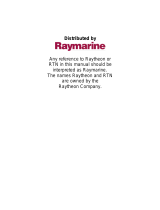
1-2 HD Series Fishfinders
Introduction
This handbook describes the display unit controls and details both fishfinder
and chart operations. Controls that are specific to either fishfinder or
chartplotter are described in fishfinder or chart sections/chapters.
Note: Many illustrations in this handbook show example screens. The screen
you see on your display depends on your system configuration and set up op-
tions, so it may differ from the illustration.
How to Use This Handbook
If you are installing the display system yourself, you should read Chapter 2
before you start the installation. This chapter also provides information that
will be useful if you are connecting your fishfinder system to other equipment.
For an overview of the display unit controls, the fishfinder and the chartplotter
systems, read Chapter 1. Chapter 3 will help you start using your system.
For detailed information on sonar operations refer to Chapter 6.
For chartplotter operating details, refer to Chapter 7 and Chapter 8.
To change the system set up defaults, read Chapter 4.
Chapter 2 provides planning considerations and detailed instructions for
installing the fishfinder display unit and sounder module. You should refer to
it when you are ready to install the system. Details to connect the display to
other equipment via
hsb
2
, NMEA, and SeaTalk are also provided.
Chapter 3 explains how to start using the display and describes how to use
some of the basic fishfinder and chart functions and Simulator Mode.
Chapter 4 provides instructions for setting up your system to suit your
preferences. You should read this chapter to determine how to change the
fishfinder and chartplotter system from the default settings.
Chapter 5 details operating the display unit’s controls in Sonar mode.
Chapters 6 provides detailed operating information for the sonar functions:
selecting depth range limits, adjusting gain, color and STC, setting alarms,
using the VRM marker, marks and man overboard.
Chapter 7 provides detailed operating information for the standard
chartplotter functions: using chart cards, plotting waypoints and routes,
following routes and showing tracks. Chapter 7 also provides operating
guidelines for typical chartplotter scenarios. These guidelines introduce you
to many of the chartplotter functions.
Chapter 8 provides detailed operating information for further chart functions,
including measuring distances, man overboard and cursor echo. It includes
instructions for setting up a differential GPS.
81213_1.book Page 2 Monday, March 17, 2003 1:14 PM






















